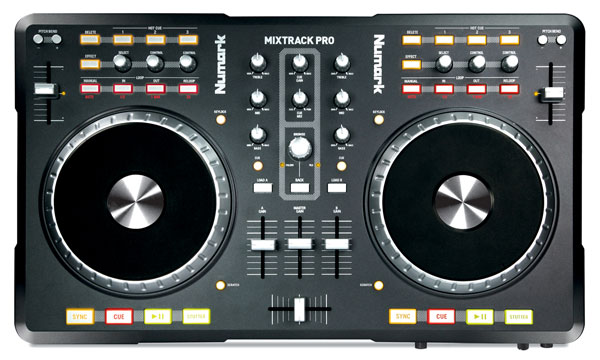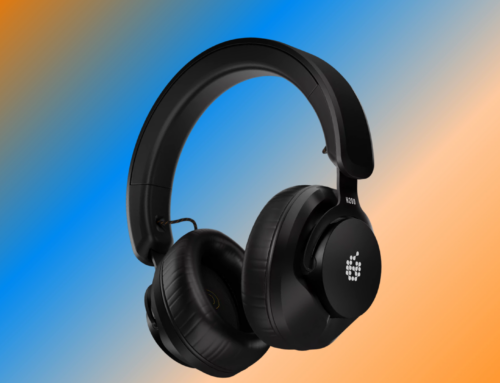
Numark MixTrack Pro VS. American Audio VMS4
I know. I know. You’d rather click the ‘Congratulations!’ pop-up to try and win that free iPad than listen to me wax poetic on the advantages and disadvantages of two of the lowest-end controllers on the DJ market. I know! But hey, before you do, I should tell you – those ads are totally bogus. And this review just may be relevant after all.
Let me take the time to personalize it for you. I came up using the tables. Friends, there was once a day when I had more space than I knew what to do with. My tables, mixers, records, speakers, instruments, amps, and controllers lived in a sprawling basement fit for a DJ named King. But as I’m sure most of you have figured out, you can’t stay at mom and dad’s forever. Impressive and comfortable as it may be, it’s no place to bring a lady home at the end of the night, and it’s no place to make a name for oneself as a producer either. So I filled a U-Haul to the brim with all the gear I’d amassed over the years and set out across the country with my sights on New York (just like everybody else). I brought it all. And after about a month of arranging and rearranging, I was left with almost enough space to stand. Facing one way I could stand at my tables and mix. Facing the other way I could cook breakfast. A dream come true (for roughly five minutes).
DJ Downsize became my new project. I bought Serato. Started digitizing every record I brought (400 of about 2500 I left at home). But even then, it wasn’t comfortable. I grew to hate the fact that I’d made the switch to digital, was now inextricably tied to my laptop, which held all the music I once had to dig around for, and yet Serato still required me to plug in and stand at my tables if I wanted to try out an idea.
Around that time I started working with Virtual DJ. I could stay seated on my couch and quickly rifle through a whole set without having to move a muscle. If something didn’t work, I could scrap it. I could keep my Serato crates organized and still make changes. And the fact that I didn’t have to stand at the tables meant I wouldn’t have to suck in and stand on my tippy toes whenever one of my roommates wanted to use the kitchen. Glorious.
As I grew more comfortable using VDJ as a practice tool, the idea of using a controller began to make more and more sense. I didn’t readily admit it at the time, but it was an issue of practicality. If I could avoid having to stand at the tables, but still try out new ideas the way I’d gotten used to, I just might have it made, no?
So I picked up a Mixtrack Pro. I’m not going to exaggerate. It didn’t change my life. But it made practicing easier for me given the circumstances. I never intended to use it out. The humiliation! But I’ve ended up using it for a couple different gigs, and honestly, why would you ever want to lug around hundreds of pounds worth of gear when you don’t have to? Save the cab fare and get a gym membership if you’re into that sort of thing. I prefer my tables. I always will. But the Mixtrack Pro has saved me time and energy, no doubt.

Numark MixTrack Pro
That brings us up to date, and you know what that means children: let’s dive in. I recently flew back home to DJ my cousin’s wedding and partly because I knew I was going to have to check my controller and partly because I care about you all so much that I happily drop major coinage for the sake of writing meaningful reviews, I bought a VMS-4 (American Audio) on a whim. I’d never used one before. The price-point is indeed higher than that of the Mixtrack Pro (about $400 vs $250), but I went used (for $300) and I haven’t looked back (yet).
Ch-Ch-Check it:
The Mixtrack Pro is super lightweight, at the expense of being a little more on the fragile side. The buttons come loose over time, especially if you’re easily excited and like to hit that cue with intention, like me. I knocked both sync buttons in on mine not too long ago and Numark wasn’t all that helpful in helping me solve the problem. Tisk, tisk. The faders are also pretty easy to bend if you’re rough with them.
That said, the layout is about as intuitive as it gets, particularly if you’re already using VDJ. It’s simple. Plug, and play. The platters are nice and big and they’re touch sensitive. Hot technology. But dangerously sensitive for use in club mode. I’d be afraid of accidentally grazing the platter and stopping the track momentarily. It wouldn’t be hard to do. The jogging feature works great–perfect for when your sync buttons fall through. And the knob feature–for scrolling through crates and navigating the interface– is surprisingly intuitive. It’s easy to get used to and honestly may eventually prove a better solution than the mousepad-style feature on the VMS4, but we’ll see. Perhaps a push/pull feature would be good for jumping between menus.
A couple of hints:
- I set the ‘Delete’ cue button on the top of the controller to act as Cue 1. You’re probably not setting too many cues on the fly, so having to use the mouse to delete one shouldn’t be too big of a deal. The touch sensitive platter makes setting those cues extremely easy.
- Map the ‘Pitch Bend +’ buttons to function as BPM-set. VDJ has trouble with BPM scanning and knowing where the ‘1’ is. Use the small buttons in the upper right and left corners for this and your problem’s solved.
- Go Pro over standard. Don’t waste your money. The soundcard is what makes this thing great for spinning your friend’s pop-up rooftop party. Just trust me. And do it.
Now. The VMS4. The thing feels as solid as a damn rock. It’s heavy as hell. And it’s got rubber corners so you can throw it around (if you can lift it). I folded it inside my suit bag and shoved it in a backpack and checked it. No problem. Surprise! Upon first glance the layout is slightly more complicated than that of the MTP. The sync button’s somewhere up top. The cues are vertical, which actually felt more natural to me, coming from the vertical-scrolling Serato waveform. There are controls on the front of the board, which may be something I’ll never get used to.

American Audio VMS4
It’s got Smart Loop features that are pretty neat. Comes with XLR output, two mic input, RCA booth, and master outs. Pro. The decks are swtichable which makes for some interesting four-deck potential. This, I heart. And of course, the mousepad. Here’s my beef with it: it’s too small to feel natural. Am I saying there’s room on the thing to make it a normal size mousepad? Naw. But a joystick would probably be easier to use for controlling the mouse than this thing. It’s slow. And loading tracks with the mini-touch buttons isn’t ideal. What else? All in all I think it was a good buy. Better than the MTP in a lot of ways. But really only if you’re planning on using it live.
If you’re using a controller for throwing around ideas and practicing a set, the MTP should suit your needs just fine. Just beware of getting too excited when pushing those buttons. But if you’ve got the money, give the VMS-4 a try. This DJ is inclined to say that in the long run, you’ll more than likely get more out of it than you would the MTP.




